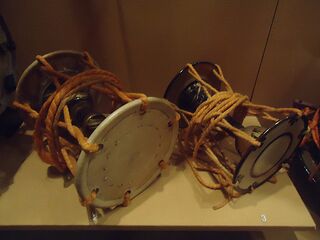Kotsuzumi

- Japanese: 小鼓 (ko tsuzumi)
The kotsuzumi, also known as a shoulder drum, is commonly featured in Noh, kabuki, nagauta, geza, and other forms of traditional and folk music. Typically paired with the ôtsuzumi (hip drum), the kotsuzumi is the smaller of the two, with a thinner skin.
Both types of drums are typically made of cherry wood, with horsehide drum heads attached by iron rings. As the skin is quite susceptible to changes in temperature and humidity, performers will often breathe on the drum skin during a performance to moisten it, ensuring the correct tone. This is in contrast to the ôtsuzumi, which must be dried to achieve the correct tone.
The instrument is held by the left hand on the right shoulder, with the performer squeezing the drum's ropes with his left hand, and striking the drum in various ways with his right hand to create a variety of sounds.
References
- Gallery labels, Musical Instruments gallery, Metropolitan Museum of Art.